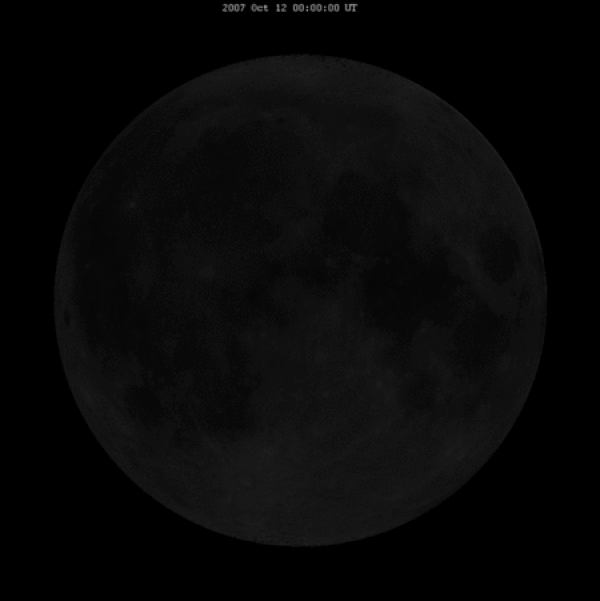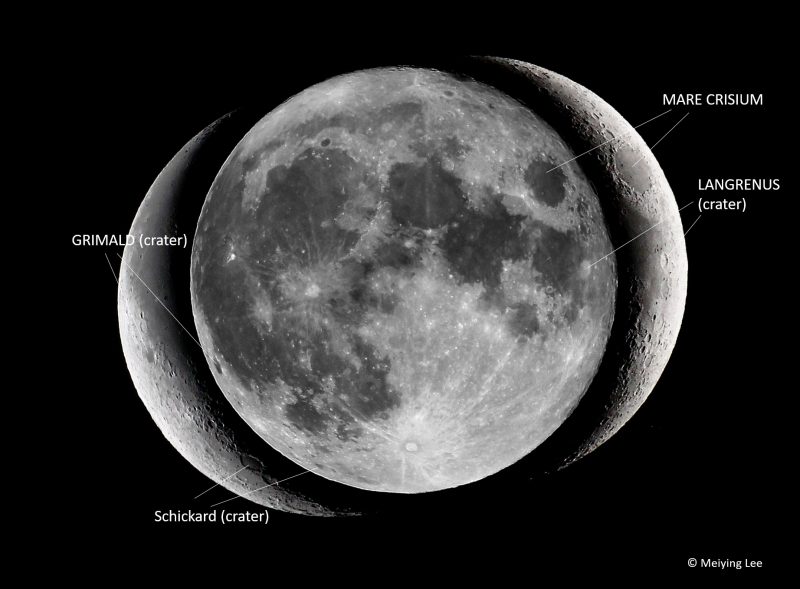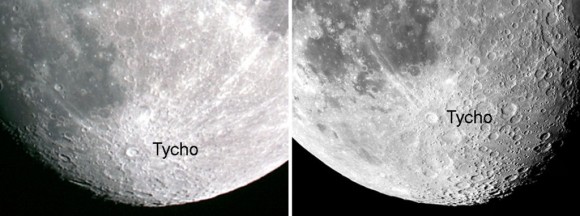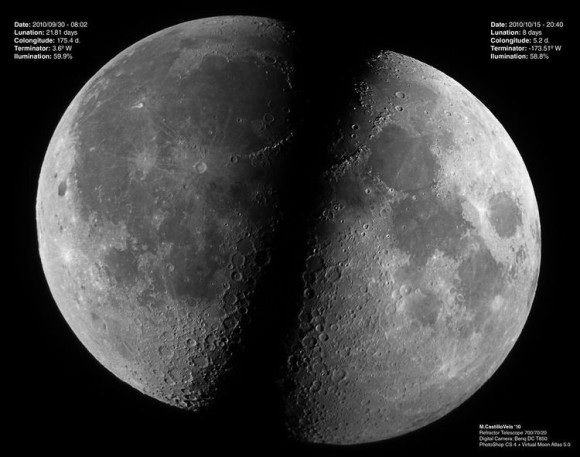
Lunar libration is a perspective effect
Editor’s Note: The moon you’ll see on January 7, 2022 will be at its maximum libration for the year of 9.89 degrees. On January 7, the moon is waxing in the evening sky. Great time to start watching!
It’s common knowledge that our moon has a near side and a far side. Indeed, most people know that half of the moon always faces Earth, and one half always points away. So, does this mean we can only see 50% of the moon’s surface from Earth? No. Over time, it’s possible to see as much as 59% of the moon’s surface, due to a combination of motions – in particular, a slight north-south rocking and east-west wobbling of the moon – known as lunar libration.
To put it another way, libration might be called a wagging or wavering of the moon, as perceived from Earth. It’s caused by changes in our perspective as we watch the moon over a month. In addition, it permits an observer to see slightly different hemispheres of the surface at different times.

Lunar libration in longitude
Libration in longitude is the moon’s east-west wobble. This sort of libration is a product of the moon’s elliptical (elongated) orbit. Although the moon’s rotation, or spin, goes at a nearly constant rate, its orbital speed varies. It is going fastest at perigee (moon’s closest point to Earth) and slowest at apogee (moon’s farthest point from Earth).
At perigee or apogee, there is no libration of longitude.
Maximum librations are seen about one week after perigee and one week after apogee, revealing (depending upon the month) up to eight degrees of longitude on the moon’s back side, along the eastern and western limbs, respectively.
Following perigee, the moon’s rotation can’t keep pace with its orbit, so a slice of the moon’s back side slips into view along the moon’s trailing limb. Following apogee, the moon’s rotation outpaces its slower orbit, causing a sliver of the moon’s back side to emerge along the leading limb.
Moon at perigee and apogee: 2001 to 2100

Lunar libration in latitude
Libration in latitude is the moon’s north-south nodding. It results primarily from the approximate five degree tilt of the moon’s orbital plane with respect to the ecliptic (Earth’s orbital plane).
Add to that, the approximate 1.5 degree tilt of the moon’s equator to the ecliptic, and you have the inclination of the moon’s equator to the plane of its orbit around Earth at some 6.5 degrees (5 + 1.5 = 6.5). Consequently, during the month, you can see about 6.5 degrees of latitude beyond the moon’s north pole, and a fortnight later, 6.5 degrees past the south pole.
Twice a month, the moon crosses the ecliptic (Earth’s orbital plane) at points called nodes. When the moon crosses the ecliptic from south to north, it’s called an ascending node. When the moon crosses the ecliptic from north to south, it’s called a descending node.
There is no libration of latitude when the moon is at its ascending node or descending node.
Maximum librations
Maximum librations happen about one week after the moon crosses either node. The moon’s southern limb is most exposed about one week after the moon crosses its ascending node, and its northern limb is maximally exposed about one week after the moon crosses its descending node.
In other words, when the moon swings farthest north of the ecliptic, the lunar south pole points most toward Earth. On the other hand, when the moon goes farthest south of the ecliptic, it’s the lunar north pole that points maximally toward our planet. At particularly favorable librations, we can see nearly seven degrees beyond either pole.
Node passages of the moon: 2001 to 2100

Other types of lunar librations
In addition, your position on Earth also has some, but significantly less, bearing on latitudinal libration. If you reside at a far northern latitude in the Northern Hemisphere, you see further north on the moon than does someone in the Southern Hemisphere. Of course, the reverse is also true: someone in the Southern Hemisphere sees more of the moon’s southerly features.
Your position also influences longitudinal libration, though once again, only marginally. At moonrise, you can make out a little more of the moon’s east (or top) limb; and at moonset, a little more of the moon’s west (and now at top) limb.
So, as you stand on Earth’s surface, it’s true that you see only 50% of the moon at any one time. And yet, all told, lunar libration – the north-south and east-west oscillations of the moon – reveal 59% of the lunar terrain.

Bottom line: A slight north-south rocking and east-west wobbling of the moon – known as lunar libration – lets us see 59% of the moon’s surface. That’s true even though one side of the moon always faces Earth. The moon’s maximum libration for the year is January 7, 2022.
Top 4 keys to understanding moon phases
Geocentric ephemeris for the moon: 2022
The post Lunar libration: January 7 moon maximum for 2022 first appeared on EarthSky.
0 Commentaires